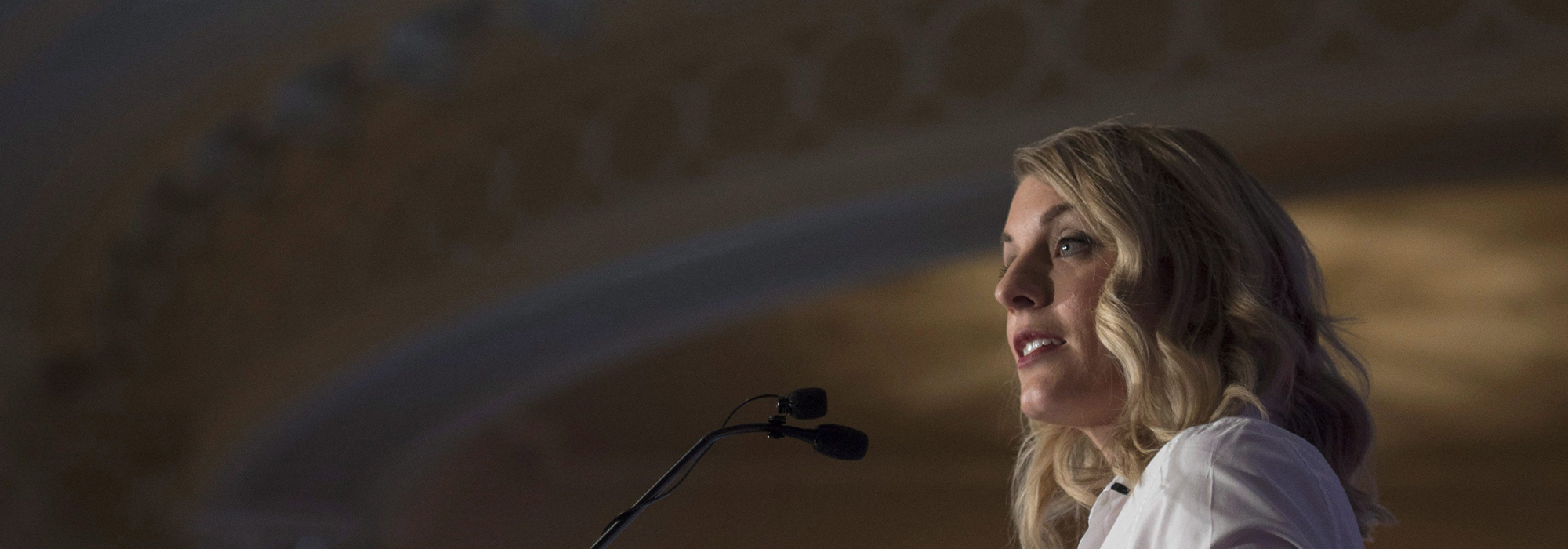
When it comes to action ensuring the future of serious journalism in Canada, Heritage Minister Mélanie Joly has a much clearer idea of what she doesn’t want than what she might be willing to accept.
The third pillar of Joly’s “Creative Canada” speech last week, which was about strengthening public broadcasting and local news, was noticeably shorter and thinner than were the other parts. This isn’t entirely surprising. In news, she is confronting one of the trickiest policy areas imaginable, in both economic and political terms.
The minister doesn’t want to bail out the private sector news industry models that are no longer viable. This is while increasing government’s traditional support for creative industries that lack of commercial viability – meaning they’ve always relied on government subsidies. Most notably, she agreed to top up shortfalls in the Canada Media Fund, which came about as a result of disruptions to the business models of cable and satellite distributors.
Joly also doesn’t want to level the tax field by charging foreign sellers of digital services the same HST that domestic players are forced to pay.
She doesn’t want to place financial demands on platform companies like Facebook, Google and Netflix beyond voluntary contributions.
She doesn’t want to be seen to be encroaching on journalistic independence.
And, should she decide in future to take action to support news, she wants to concentrate on local news and the CBC.
In articulating a vision for the cultural industries, Joly has focused on creative industry storytelling that can appeal to global markets.
But the economics of news is different from that of other cultural industries. Unlike novels, feature films or video games, news is highly perishable, and much of it is inherently local, which mitigates against an export strategy. The models that would enable existing news organizations and, notably, digital start-ups, to produce sufficient revenue to finance journalism, have not emerged, and a great deal more experimentation will be required.
Any threat to journalistic integrity is totally unacceptable. But that does not mean there should be no policy on news organizations, which provide coverage of our democracy in its many forms.
The political challenges presented by the news industry are daunting. How can policy ensure the survival of original reporting, which is so vital to democracy, without compromising the independence of the media? Any threat to journalistic integrity is totally unacceptable. But that does not mean there should be no policy on news organizations, which provide coverage of our democracy in its many forms. It just means that the government should not have discretion over individual editorial decisions.

The media policy bridge was crossed decades ago – CBC is the product of policy. Section 19 of the Income Tax Act (which prevents tax deductions for ads targeted at Canadians, but which are placed with foreign newspapers and broadcasters), is a product of a policy –one that will become moot as more ads go digital. The waiving by some provinces of sales taxes on books and newspapers is the result of policy. The CRTC’s new fund directed at local television news is a policy that already has led to the hiring of additional reporters.
Despite Joly’s rejectionist words on aid to media companies, the background documents accompanying her speech indicate she’s not necessarily done with the news file.
In her speech, she made only vague references to the Canadian Periodical Fund, which has long supported magazines and some community newspapers. But the background documents raise the possibility of modernizing the fund to ensure it “responds to industry needs.” Apparently, there’s more to come in 2018.
Joly appears to be headed – if anywhere – toward the principles set out in the Public Policy Forum’s The Shattered Mirror – a study of news, democracy and trust in the digital age, and an initiative led by the forum and news companies and unions that calls for reforms to the Periodical Fund. Both exercises identified the erosion of professional reporting capacity and the weakened ability of news organizations to underwrite digital innovation as the main deficits requiring policy attention.
The minister’s background documents also talk about reforms to improve support for digital innovation, business development and start-ups and, most critically, a possible change to the funding qualifying criteria so “eligibility could take into account original editorial content expenses, including print and digital content.” Reorienting government policy to take into account support for “original editorial” is the essence of The Shattered Mirror’s argument.
There are different routes that lead to that destination. The government clearly doesn’t like route one – imposing a levy on sellers of digital advertising in Canada that don’t invest in Canadian news gathering, and redirecting the money to those who do. The alternative route, having the Periodical Fund rebate some portion of original editorial content expenses to publishers (including digital-only publishers) through a predetermined and nondiscretionary formula, achieves many of the same ends.
The big question is, who would qualify. The Canadian Periodical Fund is currently reserved for magazines and a handful of community newspapers. If the minister wants the fund to be platform agnostic, as she states, the natural criterion is who is spending on original news, not whether they are daily, weekly or monthly, which is an artifact of the print era in any case.
As for the dreaded nonviable business models, which is to say print newspaper companies, the fact is they and legacy broadcasters generate most national, provincial and urban news; they operate leading digital news sites; and one of them, Montreal’s La Presse, has gone digital-only. So, would La Presse qualify for funding and The Globe and Mail not? Would iPolitics qualify but not The Canadian Press (CP)? Would Maclean’s, which currently receives about $1.5 million a year from the Canadian Periodical Fund, or would other publications such as Solid Waste and Recycling or Frank magazine qualify, but not winnipegfreepress.com, whitehorsestar.com or ledevoir.com?
Excluding the major originators of the country’s news, including local news, from a scheme based on original editorial content would make no sense. It is a good thing more thinking time has been allowed around the policy framework.
Several other issues the minister raised cry out for further explanation. She extolled a role for civil society in news, but has not yet offered the means by which nonprofit news organizations can become charities, and to thereby be supported directly by foundations.
Choosing not to extend the HST/GST to US operators in a global economy is one thing. Using policy to place Canadian companies at a disadvantage is something else again.
She explained that she won’t do what dozens of other jurisdictions have already done – force foreign digital services to pay the same taxes as domestic competitors – because Canada already has some of the highest Internet subscription costs in the world. If the minister doesn’t want to tax Netflix (and Facebook and Google, etc.) in order to protect taxpayers, the government can instead level the playing field by removing the tax on the digital subscriptions and advertising of the Canadian providers. Choosing not to extend the HST/GST to US operators in a global economy is one thing. Using policy to place Canadian companies at a disadvantage is something else again.
Then there’s the public broadcaster. Her speech is long on the importance of the role the CBC plays – as it should be. Moreover, she suggests, as does The Shattered Mirror, that the CBC’s mandate should be modified to put a higher premium on its news, documentary and current affairs operations.
She also calls on the CBC to become “a leading partner among Canada’s news and cultural organizations.” Does this mean the CBC should share its content more widely with start-ups and others, which would enrich the entire information ecosystem? Or does she mean the CBC should be given the responsibility of filling the growing gaps in local news resources across the country? In some places, local coverage of city council is so weak that it consists of calling the mayor the day after meetings to ask what transpired.

The minister may prefer the CBC as a vehicle because its finances are healthy, thanks to increases in parliamentary appropriations by her government. A decade ago, the 100-plus daily newspapers in Canada combined had about twice the revenues the CBC has. Today, the revenues of the daily newspapers and that of the CBC have nearly converged, and the CBC is almost twice as big as all the country’s community newspapers combined – nearly 1,000 in total.
The government should be careful not to put too many eggs in one basket, even that of a journalistically excellent public broadcaster. Diversity of news sources is one of the hallmarks of a vibrant democracy.
The Shattered Mirror proposes that a major initiative, to shore up local news, be housed as a nonprofit in CP, which is a 100-year-old bastion of the highest journalistic standards that operates in both official languages and has a presence in communities from coast to coast. A strong CBC and a strong CP, with its local news available to all comers, is the better way to reinforce local coverage of civic affairs.
The same diversity should be sought when it comes to Indigenous news, in this era of reconciliation and evolving nation-to-nation relations. The only mention of Indigenous news in the minister’s speech was in reference, once again, to the role to be played by the CBC. The Aboriginal People’s Television Network was skipped over entirely. The minister will have time to reconsider. Indigenous journalists working for Indigenous institutions should be at the forefront of Indigenous news coverage.
Finally, while the minister appropriately decried “filter bubbles” – the directing of information to a user to reinforce their online preferences – she placed no demands on the algorithm-driven platforms that build these virtual walls. Germany, Britain and even the US have tried to address the filter bubble issue. Although Joly cited a public interest in bursting filter bubbles, she limited herself to praising an unspecified contribution by Facebook to digital news innovation. The one has little to do with the other.
As of now, the government seems to not share the sense of urgency felt by journalists and media owners about the continuing deterioration of journalism in Canada.
But the economic and political situations may well change over the next year. In a little-noticed report in August, Moody’s Investor Service said Postmedia has an “unsustainable capital structure,” and that its finances may be “insufficient to support its operations over the next 12-18 months.” A reading of the tea leaves also suggests the patience of billionaire families like the Thomsons (The Globe and Mail) and the Desmarais (La Presse) to underwrite losses in their news operations may be wearing thin.
The possibility exists for a meeting of minds between the government and the news industry. Among the political hurdles faced by governments on news is a questioning of the defensibility of providing support to companies owned by domestic billionaires and foreign hedge funds. There would be less static if, as part of a future support package, these enterprises agreed to become (officially) nonprofits. In the case of newspaper chains, each individual newspaper could be sold to owners based in the local communities.
In the wake of Joly’s speech, there is still work to be done on the tough policy issues. The good news is there is an apparent willingness on the part of the government to keep the conversation going.
Photo: Minister of Canadian Heritage Melanie Joly speaks, outlining the government’s vision for cultural and creative industries in a digital world, on September 28, 2017. THE CANADIAN PRESS/Adrian Wyld
Do you have something to say about the article you just read? Be part of the Policy Options discussion, and send in your own submission. Here is a link on how to do it. | Souhaitez-vous réagir à cet article ? Joignez-vous aux débats d’Options politiques et soumettez-nous votre texte en suivant ces directives.









